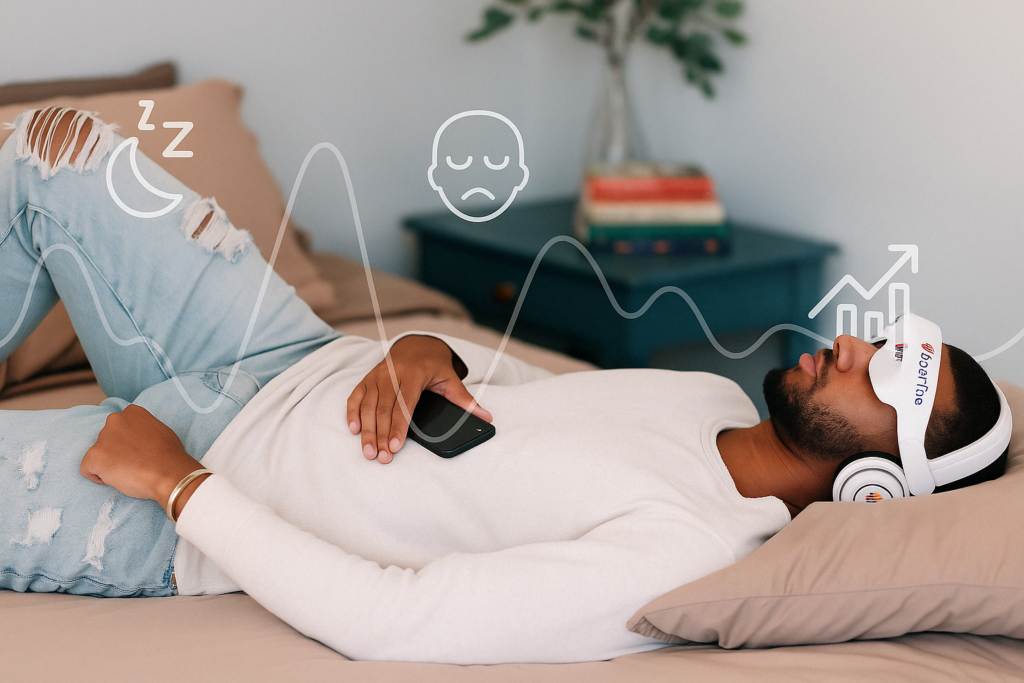The Effect of the Peak Performance Method (PPM) combined with Audio Brain Entrainment on Anxiety, Sleep, Stress and Work Productivity of Professionals
Julia Arndt1, Patrick K Porter1, Francisco J Cidral-Filho2
1. Postgraduate Program in Integrative Medicine. Quantum University. Honolulu, HI.
2. Laboratory of Experimental Neurosciences (LaNEX), University of Southern Santa Catarina, Brazil.
Background
Developed by Julia Arndt, the Peak Performance Method (PPM) combines critical productivity, mindfulness and leadership tools with neuroscientific research on emotion regulation, habit-building and change management as well as coaching techniques to help people develop the next workplace superpower to thrive in today’s high-pressure environments. Audio Brain Entertainment (ABWE) guides the mind from an awake, reactionary mind into an intuitive, creative state, then to a place where super-learning and healing can occur, with the outcome being a heightened state of consciousness with crystal clear focus. ABWE creates a symphony of brainwave activity, a feeling of calm focus for learning and productivity. Each session is designed with brainwave balance in mind. Unlike meditation programs, BrainTap’s exclusive neuro-algorithms gently and naturally guide your brain through a broad range of brainwave patterns, instead of just the Alpha state. The result is a complete spectrum of brainwave activity.
Objective
The objective of this study was to investigate the effect of the Peak Performance Method (PPM) combined with Audio Brain Entrainment (ABWE) on Anxiety, General Health, Stress, Quality of Sleep, mindset and Work productivity of professionals.
Methods
Sample size consisted of 20 professionals of varying backgrounds (14 females and 6 males aged between 28 and 55). Professionals work in tech, consulting and
telecommunication. 14 individuals are currently employed full-time, 5 individuals are self-employed and 1 not employed at the time. Group 1 and 2 learned the basics of PPM in 9
weekly pre-recorded 30-45-minute sessions, each session including a workbook with 3-5 journaling prompts for self-reflection and additional action items. Additionally, the participants were asked to complete a 5-minute reflection exercise at the end of each day to increase self-awareness and promote well-being. Furthermore, Group 2 deepened their learnings by adding 20-minute PPM-Braintap sessions 3 times a week for 9 weeks to influence their subconscious mind to make long-lasting changes in the following three areas: mindfulness, productivity and leadership.
The following questionnaires were applied at baseline and after 9 weeks to analyze the participants change in stress, sleep, mindset and productivity:
• Perceived Stress Scale (PSS);
• Pittsburgh Quality of Sleep Index (PQSI);
• Depression Scale (PQ-8);
• Mindset Scale by Carol Dweck;
• PPM Scale by Julia Arndt (not validated).
Results
PPM whether or not combined with ABWE positively affected all scores. Results indicate positive effects of PPM on all scales evaluated. When PPM was combined with ABWE effects were more pronounced in most scales.
• PSS (33% reduction for PPM and 45% when combined with ABWE). In this scale a score of 0-13 indicates low stress levels; 14-26 – moderate stress and 27-40 – high perceived stress.
• PHQ-8 (18% reduction for PPM and 71% when combined with ABWE). Patient Health Questionnaire depression scale (PHQ-8) is established as a valid diagnostic and severity measure for depressive disorders. A score of 10 or greater is considered major depression, 20 or more is severe major depression. Statistically significant results were obtained in post-hoc analysis when comparing PPM+ABWE group with its baseline (p<0.05).
• PQSI (48% reduction for PPM and 51% when combined with ABWE). PQSI global score ranges from 0 to 21. Higher scores indicate worse sleep quality. Global sum of “5” or greater indicates a “poor” sleeper.
• Work Dimension (26% increase for PPM and 28% when combined with BrainTapping). The higher the score the better the outcome. Statistically significant results were obtained in post-hoc analysis when comparing PPM+ABWE group with its baseline (p<0.05).
• Mindset (41% increase for PPM and 19% when combined with ABWE). The higher the score the better the outcome.
• Beliefs and Values (10% increase for PPM and 3% when combined with ABWE). The higher the score the better the outcome.
Conclusion
Despite the reduced sample size (N=12 participants completed the study end-to-end) PPM positively affected scores related to anxiety, general health, stress, quality of sleep, as well as work productivity. Additionally, combining ABWE with PPM leads to more significant effects on most of the outcomes assessed in this study. Statistically significant results were obtained in post-hoc analysis when comparing PPM+ABWE group with its baseline (p<0.05) in two scales: PHQ-8 and Work Dimension assessments. A larger sample size study is necessary to statistically confirm the effects of PPM and the combination with ABWE.
Figures

Figure 1: Effect of Peak Performance Method (PPM) and combination with Audio Brainwave Entrainment on Perceived Stress Scale (PSS), Patient Health Questionnaire (PHQ-8) and Pittsburgh Quality of Sleep Index (PQSI). *p<0.05 when comparing PPM+ABWE group with Baseline (Two-way ANOVA repeated Measures followed by Bonferroni Post-hoc analysis – prism Graphpad 9, La Jola, CA, USA).

Figure 2: Effect of Peak Performance Method (PPM) and combination with ABWE on Work Dimension, Mindset and Beliefs and Values Assessment. *p<0.05 when comparing PPM+ABWE group with Baseline (Two-way ANOVA repeated Measures followed by Bonferroni Post-hoc analysis – prism Graphpad 9, La
Jola, CA, USA).
Study #11 – Study conducted by Dr. Arkfeld at the Gaylord High School in Gaylord, MI, United States. 2020-2021.
